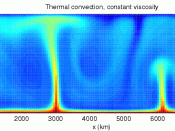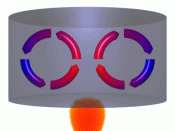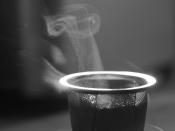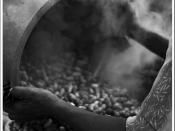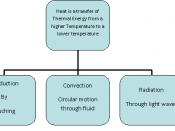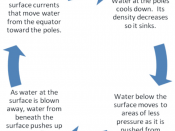Introduction Heat is transferred through convection, conduction and radiation. Convection is the transfer of heat through the movement of matter. Conduction is the transfer of heat or energy between two objects that are in contact with each other. Radiation is the transfer of energy through electromagnetic waves. In this lab we conducted four separate experiments. The experiments test to see how convection currents cause effects on an ecosystem.
Experiment 1 In this experiment, we tested to see if liquids in an ecosystem could cause convection currents. We poured hot water into a flask. We colored it with half a teaspoon of potassium permanganate (just to distinguish it from others). The flask was plugged with a double-holed rubber stopper. The purple colored water in the flask sunk to the bottom of the graduated cylinder.
Analysis 1 The purple dyed water came out of one of the glass droppers into the large portion of hot water, which wasn?t as hot as the water in the flask.
The purple water reached the surface while the clear water was being pushed down. This illustrated convection of liquids. The currents eventually reached thermal equilibrium and convection stopped. All the water was purple and reached one temperature.
Experiment 2 There was a cardboard juice box container that was cut in the middle to create a window. Two holes were made on the top and sticking out of the holes were cardboard toilet paper roles. Inside the box was a small crucible containing hydraulic acid, ammonium hydroxide and directly under the toilet paper roll was a lit candle. The window was covered with plastic wrap so that nothing could escape.
Analysis The candle was a heat source that sped up the movement of the molecules. The molecules were less dense and you could see smoke coming from the right toilet paper roll. Ammonium Chloride and water created salt. The heat leaving the container created a convection current, and the salt released a white gas in the air.
Experiment 3 We had split up into groups of four. Each group got three separate pieces of clay that we had to make into flat rectangles as thin as possible. They were all stacked on top of each other when shaped. The objective was to use three different techniques that put pressure on the layered pieces of clay. These forces had to either push or pull like plate tectonics. The clay was pulled apart, pushed inward going up and pushed inward going down.
Analysis When the clay was pulled apart, it split in two. When the clay was pushed in it either created a mountain (volcano) or a hole in the ground. On earth, plate techtonics create forces which are caused by convection currents. Under the ground magma is causing convection currents from heat and pressure. The experiment shows what might happen in real life if plates begin to slide.
Conclusion Convection currents affect all living organisms. Pressure, heat and time plays a big role in transfer of heat and the flow of different materials. In all these experiments we saw convection in three different ways. The first was in the flask, when it showed convection of a liquid. The second one we saw was the convection of a gas in the juice box. The third and final one we saw was the convection of a solid when we used the clay to represent plate tectonics.
